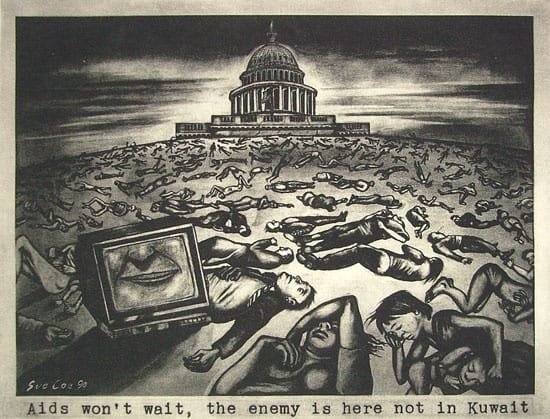Aids won’t wait, the enemy is here not in Kuwait, Sue Coe
Sue Coe, Aids won’t wait, the enemy is here not in Kuwait, 1990, photo-etching on paper, Pennsylvania Academy of the Fine Arts.
In the haunting tapestry of Sue Coe's political imagery, "AIDS won't wait, the enemy is here not in Kuwait," the artist orchestrates a visual symphony that transcends the canvas to echo the profound silence surrounding the AIDS crisis in the late 20th century. Coe, renowned for her unflinching political commentary, unveils a battlefield where bodies are laid out in a composition reminiscent of traditional battle scenes. However, in this visceral depiction, there are no weapons—only the casualties of a war that unfolded not on foreign soil but within the very fabric of United States politics.
Rendered in stark black and white, the image speaks to the binary nature of the AIDS crisis—a crisis the government was slow to address. The environmental curvature seems to envelop the entire world, mirroring the insidious spread of AIDS at the time. Coe's choice of monochrome serves as a visual metaphor for the urgency of the issue, demanding the government's attention in no uncertain terms.
The AIDS crisis, Coe contends, is not a nuanced matter; it's black and white, and the government must act. Acknowledged by the Centers for Disease Control (CDC) in the early 1980s, the epidemic languished in political inertia. The Reagan and Bush administrations were slow to speak about it, and the blame was unjustly placed on the gay community, branding it a moral disease rather than a public health concern.
As the United States mobilized for the Gulf War in 1990, Coe's canvas raises a poignant question: How can a nation so easily rally for war abroad while neglecting the thousands dying from AIDS on its own soil? The juxtaposition of the Gulf War, with territorial interests and economic stakes at play, against the silent backdrop of the AIDS crisis speaks volumes about the skewed priorities of policymakers.
Coe skillfully interweaves symbols of silence into her composition. A television set with a firmly closed mouth becomes a metaphor for the lack of attention on the AIDS crisis. The artist draws parallels to the media's emphasis on the Gulf War, where U.S. forces were deployed and prominently featured, while AIDS remained conspicuously absent from the news.
The visual impact deepens as Coe highlights a staggering statistic—more men died from AIDS than in the entire Vietnam War. Through this stark reminder, she challenges the choices made by the United States government, pointing out that the nation's finite resources were directed towards the Gulf War rather than crucial AIDS research.
In "AIDS won't wait," Sue Coe transcends the realm of art to become a compassionate historian, chronicling a period of collective neglect and selective priorities. Her visual narrative serves as a powerful indictment of a government's failure to address a crisis of devastating proportions. Through a poignant fusion of emotion and intelligence, Coe compels us to confront the silence, question the choices made, and reflect on the human toll exacted by the intersection of politics and a silent epidemic.
